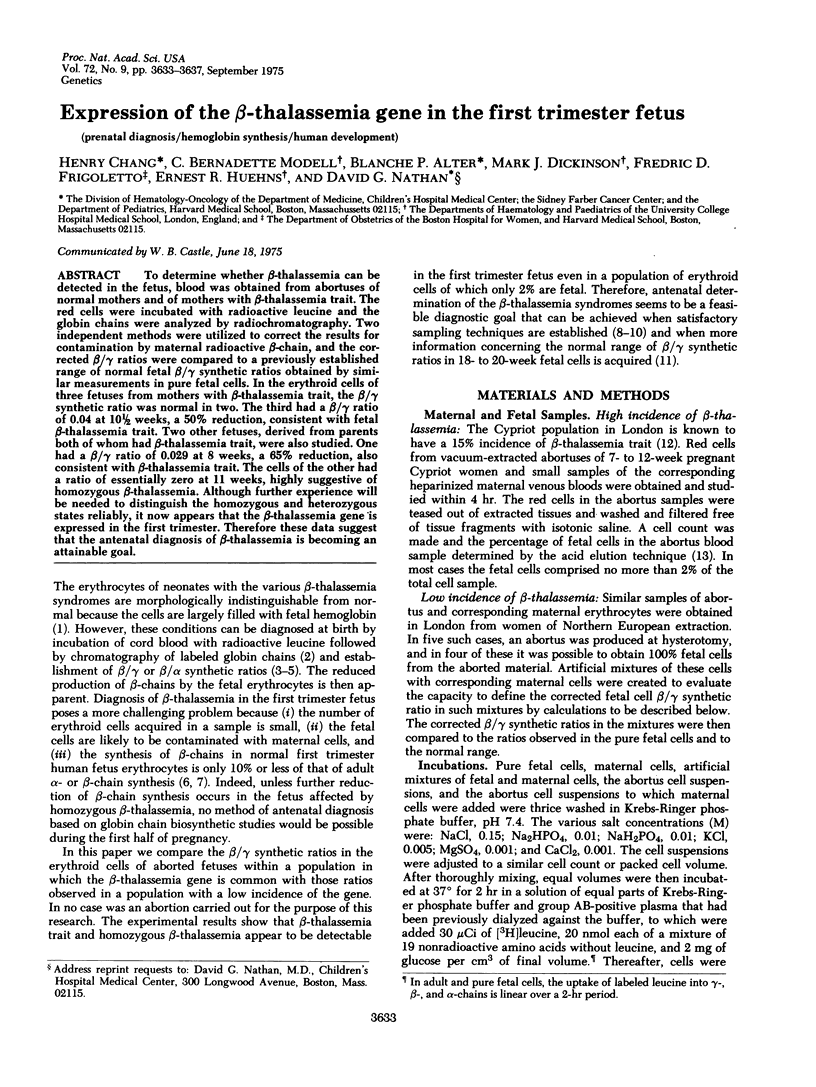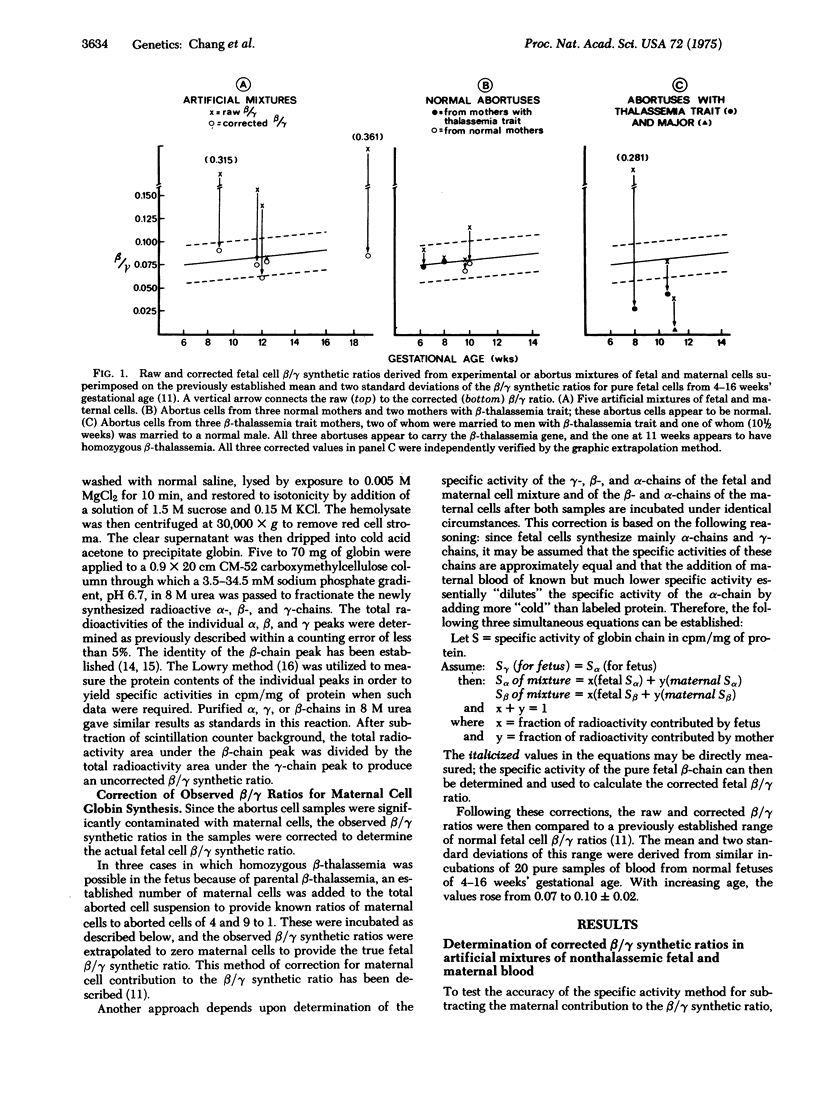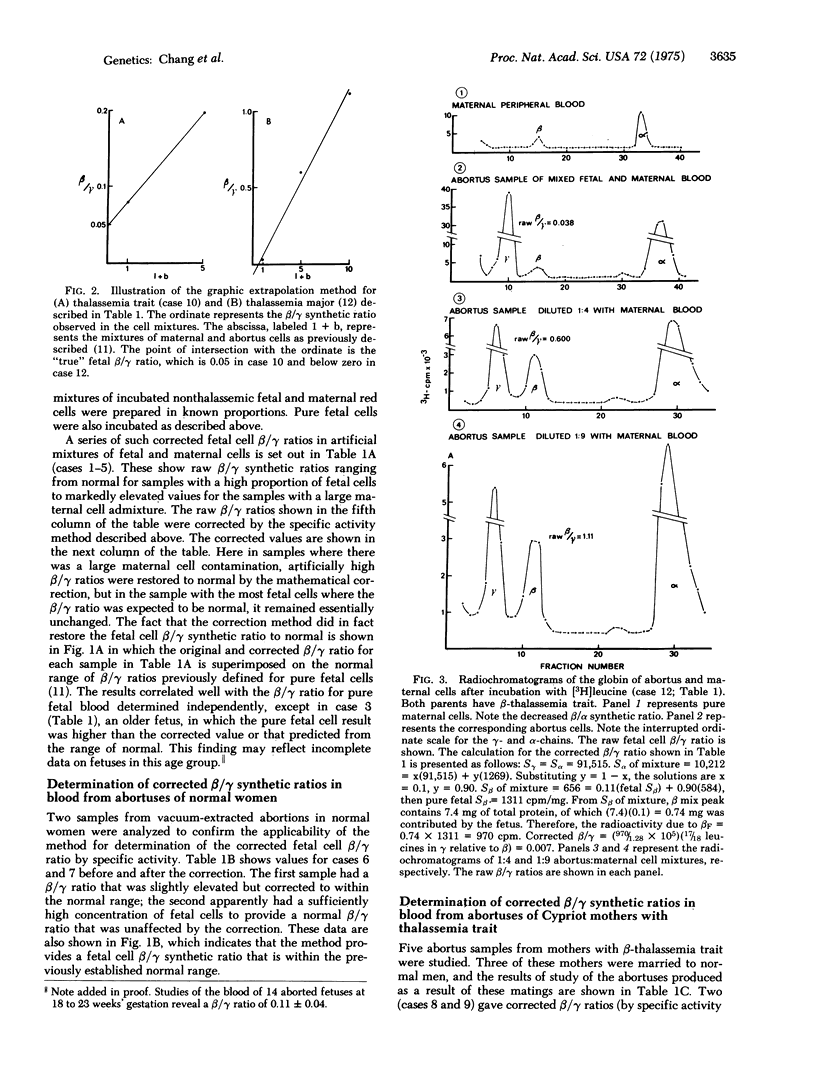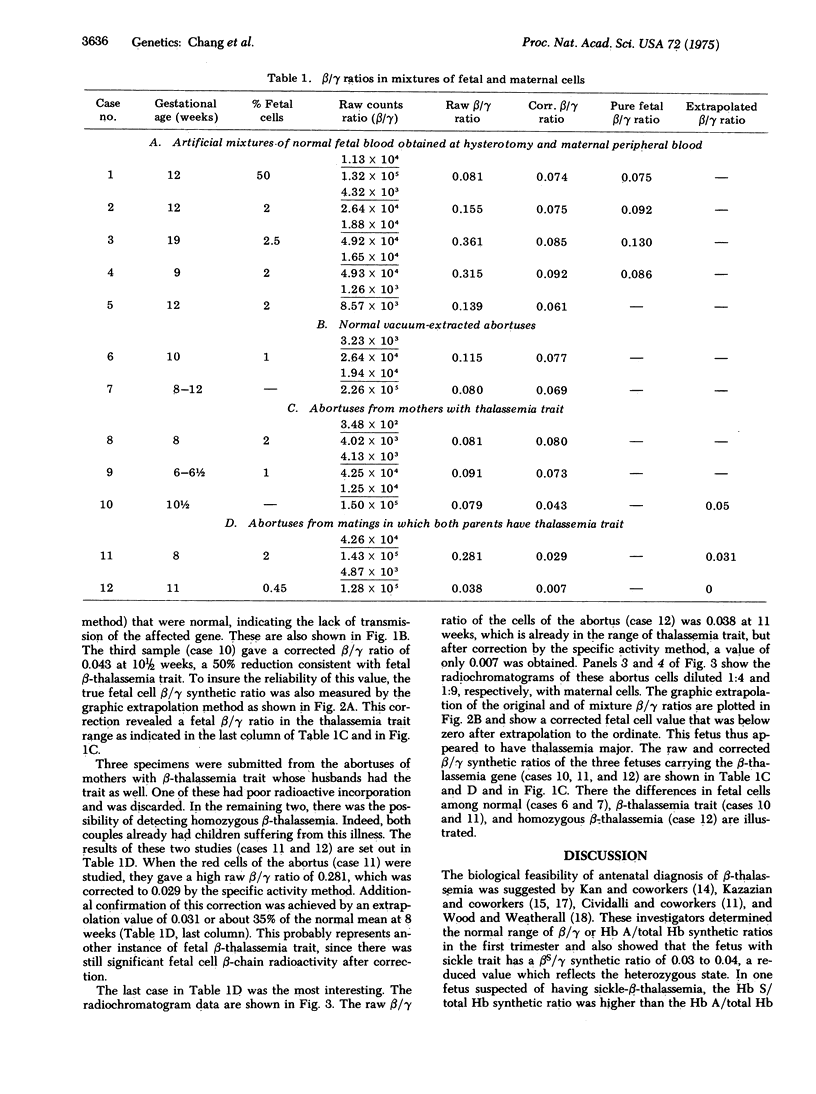Abstract
To determine whether beta-thalassemia can be detected in the fetus, blood was obtained from abortuses of normal mothers and of mothers with beta-thalassemia trait. The red cells were incubated with radioactive leucine and the globin chains were analyzed by radiochromatography. Two independent methods were utilized to correct the results for contamination by maternal radioactive beta-chain, and the corrected beta/gamma ratios were compared to a previously established range of normal fetal beta/gamma synthetic ratios obtained by similar measurements in pure fetal cells. In the erythroid cells of three fetuses from mothers with beta-thalassemia trait, the beta/gamma synthetic ratio was normal in two. The third had a beta/gamma ratio of 0.04 at 10 1/2 weeks, a 50% reduction, consistent with fetal beta-thalassemia trait. Two other fetuses, derived from parents both of whom had beta-thalassemia trait, were also studied. One had a beta/gamma ratio of 0.029 at 8 weeks, a 65% reduction, also consistent with beta-thalassemia trait. The cells of the other had a ratio of essentially zero at 11 weeks, highly suggestive of homozygous beta-thalassemia. Although further experience will be needed to distinguish the homozygous and heterozygous states reliably, it now appears that the beta-thalassemia gene is expressed in the first trimester. Therefore these data suggest that the antenatal diagnosis of beta-thalassemia is becoming an attainable goal.
Full text
PDF




Selected References
These references are in PubMed. This may not be the complete list of references from this article.
- Chang H., Hobbins J. C., Cividalli G., Frigoletto F. D., Mahoney M. J., Kan Y. W., Nathan D. G. In utero diagnosis of: hemoglobinopathies. Hemoglobin synthesis in fetal red cells. N Engl J Med. 1974 May 9;290(19):1067–1068. doi: 10.1056/NEJM197405092901909. [DOI] [PubMed] [Google Scholar]
- Cividalli G., Nathan D. G., Kan Y. W., Santamarina B., Frigoletto F. Relation of beta to gamma synthesis during the first trimester: an approach to prenatal diagnosis of thalassemia. Pediatr Res. 1974 May;8(5):553–560. doi: 10.1203/00006450-197405000-00004. [DOI] [PubMed] [Google Scholar]
- Clegg J. B., Naughton M. A., Weatherball D. J. Abnormal human haemoglobins. Separation and characterization of the alpha and beta chains by chromatography, and the determination of two new variants, hb Chesapeak and hb J (Bangkok). J Mol Biol. 1966 Aug;19(1):91–108. doi: 10.1016/s0022-2836(66)80052-9. [DOI] [PubMed] [Google Scholar]
- Gaburro D., Volpato S., Vigi V. Diagnosis of beta thalassaemia in the newborn by means of haemoglobin synthesis. Acta Paediatr Scand. 1970 Sep;59(5):523–528. doi: 10.1111/j.1651-2227.1970.tb16802.x. [DOI] [PubMed] [Google Scholar]
- HUEHNS E. R., DANCE N., BEAVEN G. H., HECHT F., MOTULSKY A. G. HUMAN EMBRYONIC HEMOGLOBINS. Cold Spring Harb Symp Quant Biol. 1964;29:327–331. doi: 10.1101/sqb.1964.029.01.035. [DOI] [PubMed] [Google Scholar]
- Hobbins J. C., Mahoney M. J. In utero diagnosis of hemoglobinopathies. Technic for obtaining fetal blood. N Engl J Med. 1974 May 9;290(19):1065–1067. doi: 10.1056/NEJM197405092901908. [DOI] [PubMed] [Google Scholar]
- Kan Y. W., Dozy A. M., Alter B. P., Frigoletto F. D., Nathan D. G. Detection of the sickle gene in the human fetus. Potential for intrauterine diagnosis of sickle-cell anemia. N Engl J Med. 1972 Jul 6;287(1):1–5. doi: 10.1056/NEJM197207062870101. [DOI] [PubMed] [Google Scholar]
- Kan Y. W., Forget B. G., Nathan D. G. Gamma-beta thalassemia: a cause of hemolytic disease of the newborn. N Engl J Med. 1972 Jan 20;286(3):129–134. doi: 10.1056/NEJM197201202860304. [DOI] [PubMed] [Google Scholar]
- Kan Y. W., Golbus M. S., Klein P., Dozy A. M. Successful application of prenatal diagnosis in a pregnancy at risk for homozygous beta-thalassemia. N Engl J Med. 1975 May 22;292(21):1096–1099. doi: 10.1056/NEJM197505222922104. [DOI] [PubMed] [Google Scholar]
- Kan Y. W., Nathan D. G. Beta thalassemia trait: detection at birth. Science. 1968 Aug 9;161(3841):589–590. doi: 10.1126/science.161.3841.589. [DOI] [PubMed] [Google Scholar]
- Kan Y. W., Valenti C., Carnazza V., Guidotti R., Rieder R. F. Fetal blood-sampling in utero. Lancet. 1974 Jan 19;1(7847):79–80. doi: 10.1016/s0140-6736(74)92293-4. [DOI] [PubMed] [Google Scholar]
- Kazazian H. H., Jr Editorial: Prenatal diagnosis of hemoglobinopathies. N Engl J Med. 1975 May 22;292(21):1125–1126. doi: 10.1056/NEJM197505222922113. [DOI] [PubMed] [Google Scholar]
- Kazazian H. H., Jr, Kaback M. M., Woodhead A. P., Leonard C. O., Nersesian W. S. Further studies on the antenatal detection of sickle cell anemia and other hemoglobinopathies. Adv Exp Med Biol. 1972;28:337–346. doi: 10.1007/978-1-4684-3222-0_27. [DOI] [PubMed] [Google Scholar]
- Kazazian H. H., Jr, Woodhead A. P. Hemoglobin A synthesis in the developing fetus. N Engl J Med. 1973 Jul 12;289(2):58–62. doi: 10.1056/NEJM197307122890202. [DOI] [PubMed] [Google Scholar]
- LOWRY O. H., ROSEBROUGH N. J., FARR A. L., RANDALL R. J. Protein measurement with the Folin phenol reagent. J Biol Chem. 1951 Nov;193(1):265–275. [PubMed] [Google Scholar]
- Modell C. B., Benson A., Wright C. R. Incidence of -thalassaemia trait among Cypriots in London. Br Med J. 1972 Sep 23;3(5829):737–738. doi: 10.1136/bmj.3.5829.737. [DOI] [PMC free article] [PubMed] [Google Scholar]
- Nierhaus K., Betke K. Eine vereinfachte Modifikation der sauren Elution für die cytologische Darstellung von fetalem Hämoglobin. Klin Wochenschr. 1968 Jan 1;46(1):47–47. doi: 10.1007/BF01725302. [DOI] [PubMed] [Google Scholar]
- Wood W. G., Weatherall D. J. Haemoglobin synthesis during human foetal development. Nature. 1973 Jul 20;244(5412):162–165. doi: 10.1038/244162a0. [DOI] [PubMed] [Google Scholar]


